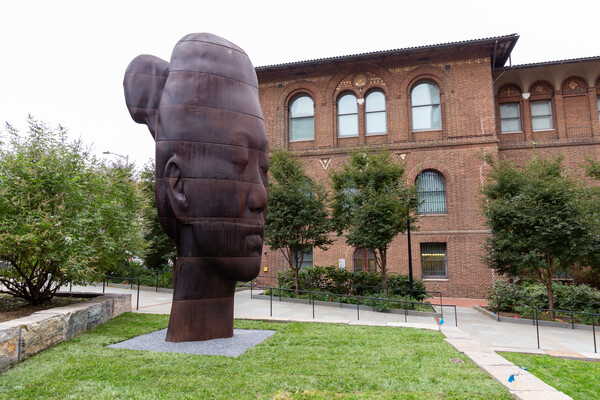
(From left) Doctoral student Hannah Yamagata, research assistant professor Kushol Gupta, and postdoctoral fellow Marshall Padilla holding 3D-printed models of nanoparticles.
(Image: Bella Ciervo)
Stuart Weitzman Hall, the compact Italianate building across South 34th Street from Meyerson Hall that has served generations of fine arts students at Penn, is rapidly being transformed into the new headquarters for the Department of Fine Arts and an interdisciplinary hub for the Stuart Weitzman School of Design. In its new life, the building will serve many of the same purposes it has for decades, with art studios, maker spaces, offices and classrooms. Its façade and much of the original structure will also remain. But, with a significant new addition designed by the Philadelphia architecture firm KieranTimberlake in consultation with Preservation Design Partnership, the building’s interior will be dramatically transformed.
Last spring, just before the renovation began, a group of historic preservation students set out to record the existing conditions of Weitzman Hall, formerly known as the Morgan Building. The methods they used—photographing exterior and interior spaces, drawing plans, sections and elevations—are the essential tools of preservation documentation. But unlike a typical scenario, in which documentation and surveying might be used to inform a faithful restoration of a historic space, students in this case were producing a definitive, public record of a space that was about to be profoundly altered.
“We said to the students, ‘A lot of this is going to be lost forever. So it’s important that we document it now,’” says John Hinchman, a senior research associate at Weitzman’s Center for Architectural Conservation and lecturer in the Department of Historic Preservation.
Hinchman led the course—Documentation, Research, Recording II, a core course for preservation students—in collaboration with Lecturer Joseph Elliott, a specialist in architectural photography. The two have taught the course together for the last five years. It’s the follow-up to a core fall course which is focused on historic research. Often, Hinchman and Elliott have worked with Holy Apostles and the Mediator Episcopal church at 51st and Spruce streets, where students had a chance to learn the skills of documentation while providing detailed records for the church. But Weitzman Hall was the first time they were able to use a building that was slated to be altered, which changed the stakes of the project and, to some degree, the approach students took to documentation
“Part of the assignment is forcing students to think about how to fully capture this place,” says Elliott, a former professor of art at Muhlenberg University who has submitted thousands of architectural images to HABS. “We need to crawl through this place, and not just stand back and get a good shot or shoot our laser scanner. We need to feel it. We need to physically interact with the building. For me, that’s one of the most enjoyable parts of doing this kind of work.”
This story is by Jared Brey. Read more at Weitzman News.
From the Weitzman School of Design

(From left) Doctoral student Hannah Yamagata, research assistant professor Kushol Gupta, and postdoctoral fellow Marshall Padilla holding 3D-printed models of nanoparticles.
(Image: Bella Ciervo)

Jin Liu, Penn’s newest economics faculty member, specializes in international trade.
nocred

nocred

nocred